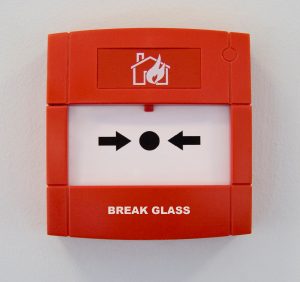Description
There’s always something new you can learn to improve your fire safety knowledge and today we’ll look at yet another key element of your fire detection system – the manual call points (MCP) used to activate your fire alarm. From what they actually do and where to find them to using and testing them correctly – here’s everything you need to know about fire alarm call points.
What is a fire alarm call point & what does it do?
A fire alarm call point (also referred to as a red manual call point or a break-glass call point) is essentially a small box, mounted on a wall which contains a button or a lever that allows you to manually trigger the fire alarm in a building.
They are an essential part of any building’s fire detection system, as they can:
- alert everyone inside to a potential fire danger by sounding the alarm
- get the evacuation process started as quickly as possible
- sound the alarm even if the automated detection system has failed
- notify the fire alarm control panel about the area where the fire is
- alert the fire services about the fire (can be done manually or automatically)
- activate the smoke management system
Depending on the model of the call point you may or may not have to break a glass to reach the button that activates the fire alarm. Some of the latest designs have been adapted to use depressable plastic instead of glass to reduce the possibility of injury to the user and to discourage any acts of vandalism.
If you happen to uncover a fire at work, sounding the fire alarm using a manual call point is the fastest way to get your colleagues’ attention and prompt them to get to safety. If the fire isn’t big enough to have triggered the automatic fire detection system, your proactive actions could help put the flames under control before the fire has had the chance to spread.
Once the manual call point has been used, it has to be reset manually, using a safety key to revert it back to its original state.
Where should fire call points be located?
Every fire alarm system has multiple manual call points, so if you pay attention, you will spot them in all public buildings – from shared accommodation to office buildings, construction sites, cinemas and theatres, shopping centres, school and healthcare facilities.
Usually, they are located along the escape routes, near the fire exits, so that you can trigger the alarm without slowing down the evacuation process or putting yourself in unnecessary danger. According to the relevant regulatory requirements (BS 5839), call points should be placed:
- On each floor of a building
- No more than 30 metres from any point in the building
- No higher than 1.4 metres above the floor
- In a visible & accessible location
- Additionally, in areas identified as high-risk
Another interesting fact about manual call points is that they should always be installed on the floor side of an exit door leading to a staircase so that when the alarm is triggered, the alarm system can correctly identify which floor the fire has occurred on.
What colour are the fire alarm call points?
Manual call points can have more than one function. They come in three colours: white, green and red. The different colours indicate the function of each individual call point:
- Red manual call points: Those are the fire alarm call points used to activate the fire alarm, notify the fire services and even trigger the sprinkler or smoke control systems
- Green manual call points: Those are located next to an exit and they are used to manually release a door while trying to evacuate the building in the event of an emergency
- White manual call points: Since those don’t indicate a single function, there should be additional signage telling you what this particular call point does. However, there’s one thing white manual call points can’t be used for and that’s to call the fire services
Depending on the fire safety system installed in your building, the manual call points can be set up to have a number of additional functions, such as unlocking or releasing doors, triggering the smoke management system and even turning off the air conditioning system. In any case, if you notice a fire, you should always use the manual call points without hesitation – better safe than sorry!
How often should fire call points be tested?
Manual call points should be tested as part of your weekly fire alarm test procedure. Realistically, not all fire alarm call points can be tested each week. Usually, the testing is done via a rotation plan where a different call point is tested each week to ensure that the entire system works as it should. If there are 12 call points on the premises, for example, you shouldn’t retest the first call point before the 13th week of testing, as all 12 call points should be tested before you repeat the process.
In addition to that, it’s part of the fire marshal’s responsibilities to perform a daily visual inspection of all elements of the fire safety system, including the manual call points. If the call point signage has worn off or if there are any visible signs of damage, then this should be raised with the building’s management team and rectified as quickly as possible.
Last but not least, the entire fire alarm system has to undergo a full safety inspection by a qualified fire safety engineer at least every 6 months. This is when all manual call points will be checked thoroughly by a professional as part of their regular maintenance.
Need a fire alarm system along with manual call points installed? Here at Evacuator Alarms, we specialise in traditional and wireless fire alarm installation for all building projects, from residential buildings to offices and large






Reviews
There are no reviews yet.